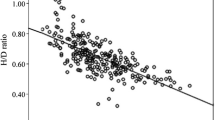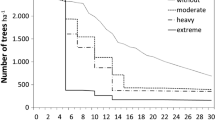Abstract
The effect of first thinning and pruning on height, diameter at breast height (DBH), and volume growth was studied in individual trees of Pinus patula Schiede and Deppe in Chongoni Plantation, using four plots for thinning trials. Each of the plots was 0.5 ha and subjected to one of the following silvicultural treatments: first thinning and pruning, first thinning and no pruning, pruning and no thinning, and control (no pruning and no thinning). The silvicultural treatments were randomized in four replicates. Fourteen years after planting, the following parameters were measured including total height, DBH, and volume. The highest DBH and volume growth was observed in thinning and pruning, while the highest growth in height was observed where there was pruning and no thinning. Clearly, both thinning and pruning are an important management option in pine species plantations in Malawi to maximize the increase in volume productivity.
Similar content being viewed by others
References
Alcorn PJ, Bauhus J, Thomas DS, James RN, Smith RG (2008) Photosynthetic response to green crown pruning in young plantation-grown Eucalyptus pilularis and E. cloeziana. For Ecol Manag 255:3827–3838
Chroust L (2001) Thinning experiment in a Scots pine forest stand after 40-year investigations. J For Sci 47:356–365
Dieguez-Aranda U, Dorado FC, Gonzalez JGA, Alboreca AR (2006) Dynamic growth model for Scots pine (Pinus sylvestris L.) Plantations in Galicia (north-western Spain). Ecol Model 191:225–242
Dykstra DP, Monserud RA (2007) Forest growth and timber quality: crown model and simulation methods for sustainable forest management. USDA, Washington
Evans J, Turnbull J (2004) Plantation forestry in the tropics. University Press, Oxford
Forrester DI, Baker TG (2012) Growth responses to thinning and pruning in Eucalyptus globulus, Eucalyptus nitens, and Eucalyptus grandis plantations in south eastern Australia. Can J For Res 42:75–87
Gilmore DG, O’Brien TC, Hoganson HM (2005) Thinning red pine plantations and the Langsaeter hypothesis: a Northern Minnesota case study. North J Appl For 22:19–26
Gonzalez JGA, Schroder J, Soallerio RR, Gonzalez R (2002) Modeling the effects of thinnings on the diameter distribution of even-aged Maritime pine stands. For Ecol Manag 165:57–95
Guller B (2007) The effects of thinning treatments on density, MOE, MOR and maximum crushing strength of Pinus brutia Ten. wood. Ann For Sci 64:467–475
Ingram CL, Chipompha NWS (1987) The silvicultural guide book of Malawi, 2nd edn. FRIM, Zomba
Louppe D, Oteng-Amoako AA, Brink M (2008) Plant resources of tropical Africa timber. Backhuys, Wageningen
Mäkinen H, Isomäki A (2004a) Thinning intensity and long-term changes in increment and stem form of Norway spruce trees. For Ecol Manag 201:295–309
Mäkinen H, Isomäki A (2004b) Thinning intensity and growth of Scots pine stands in Finland. For Ecol Manag 201:311–325
Mäkinen H, Isomäki A (2004c) Thinning intensity and long-term changes in increment and stem form of Scots pine trees. For Ecol Manag 203:21–34
Maurin V, DesRochers A (2013) Physiological and growth responses to pruning season and intensity of hybrid poplar. For Ecol Manag 304:399–406
Medhurst JL, Pinkard EA, Beadle CL, Worledge D (2006) Photosynthetic capacity increases in Acacia melanoxylon following form pruning in a two-species plantation. For Ecol Manag 233:250–259
Neilsen WA, Pinkard EA (2003) Effects of green pruning on growth of Pinus radiata. Can J For Res 33:2067–2073
Ngaga YM (2011) Forest plantations and woodlots in Tanzania. African Forest Forum, Nairobi
Peltola H, Kilpeläinen A, Sauvala K, Räisänen T, Ikonen VP (2007) Effects of early thinning regime and tree status on the radial growth and wood density of Scots pine. Silva Fenn 41:489–505
Pinkard EA, Mohammed C, Beadle CL, Hall MF, Worledge D, Mollon A (2012) Growth responses, physiological and decay associated with pruning plantation-grown Eucalyptus globulus Labill. and E. nitens (Deane and Maiden) Maiden. For Ecol Manag 200:263–277
Río MD, Calama R, Cañellas I, Roig S, Montero G (2008) Thinning intensity and growth response in SW-European Scots pine stands. Ann For Sci 65:308–317
SAS (2004) Qualification tools user’s guide (Version 9.1.3). SAS Institute Inc, Cary
Sharma M, Smith M, Burkhart HE, Amateis R (2006) Modeling the impact of thinning on height development of dominant and codominant loblolly pine trees. Ann For Sci 63:349–354
Springmann S, Rogers R, Spiecker H (2013) Impact of artificial pruning on growth and secondary shoot development of wild cherry (Prunus avium L.). For Ecol Manag 261:764–769
Strong TR, Erdmann GG (2000) Effects of residual stand density on growth and volume production in even-aged red maple stands. Can J For Res 20:372–378
Turnbull TL, Adams MA, Warren CR (2007) Increased photosynthesis following partial defoliation of field-grown Eucalyptus globulus seedlings is not caused by increased leaf nitrogen. Tree Physiol 27:1481–1492
Varmola M, Salminen H, Timonen M (2004) Thinning response and growth trends of seeded Scots pine stands at the artic timberline. Silva Fenn 38:71–83
Yatich SK (2009) Diameter distribution prediction models for thinned slash and loblolly pine plantations in the southeast. Ph.D. Thesis, University of Georgia, Georgia
Zeide B (2001) Thinning and growth: a full turnaround. J For 99:20–25
Zeide B, Sharer D (2002) Sustainable and profitable management of even-aged loblolly pine stands. J Sustain For 14:93–106
Zhang SY, Chauret G, Swift DE, Duchesne I (2006) Effects of pre-commercial thinning on tree growth and lumber quality in a jack pine stand in New Brunswick, Canada. Can J For Res 36:945–952
Acknowledgments
The authors thank Mr. Anderson Ndema and his colleagues of Malawi College of Forestry and Wildlife (MCFW) for allowing them to take measurements from the trial plots in Chongoni Plantation.
Author information
Authors and Affiliations
Corresponding author
Additional information
The online version is available at http://www.springerlink.com
Corresponding editor: Yu Lei
Rights and permissions
About this article
Cite this article
Missanjo, E., Kamanga-Thole, G. Effect of first thinning and pruning on the individual growth of Pinus patula tree species. J. For. Res. 26, 827–831 (2015). https://doi.org/10.1007/s11676-015-0104-2
Received:
Accepted:
Published:
Issue Date:
DOI: https://doi.org/10.1007/s11676-015-0104-2




